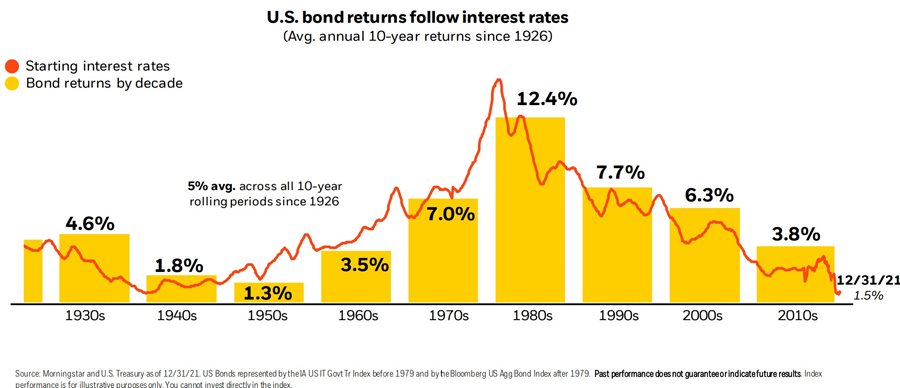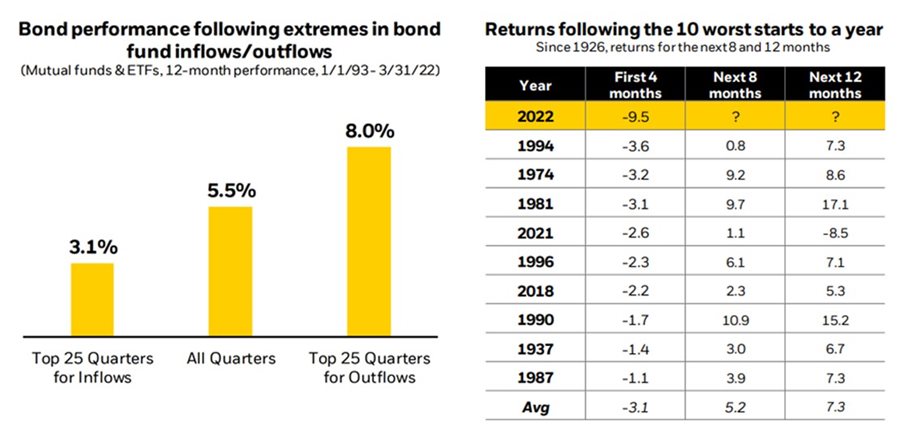Bonds are usually dependable. They sit quietly in portfolios providing low but steady returns and a reliable stream of income. They also provide diversification, typically acting as shock absorbers during stock market declines. Unfortunately, bonds have not been a safe port in the recent market storm. Stocks and bonds are falling in tandem for the first time in almost 30 years. Year-to-date through April, the bond market was down 9.5%, which is its worst start in history. Investors are understandably concerned. In this piece, we will provide our perspective on the bond market’s performance and explain what we are doing to navigate your portfolios through this period of turbulence.
Why Bond Prices are Falling
The culprit for the sharp decline in the bond market is rising interest rates. Bond prices and interest rates move in opposite directions. The yield of a 5-year Treasury note has more than tripled over the past year to 2.8%. Interest rates were artificially and historically low because the Fed was helping to restart our economy during the Covid crisis. Interest rates are now rising because the Federal Reserve intends to raise interest rates to reduce inflation. The Fed also plans to allow some of the bonds it holds on its balance sheet to mature. This is a significant reversal for the Fed, which spent much of 2021 downplaying inflation as “transitory.” In May, Federal Reserve Chairman Jay Powell admitted that inflation was “much too high.” The Fed has signaled that it is prepared to do what is necessary to bring inflation down.
Annualized inflation, as measured by the Consumer Price Index (CPI), increased to 8.3% in April, close to a 40-year high. The textbook cause of inflation is too much money in the economy chasing too few goods. Inflation is high today partly for this reason. The Federal Reserve flooded the capital markets with trillions of dollars of liquidity in 2020. While easy monetary policy was necessary at the time, the Fed should have acted earlier to tighten monetary policy. Unfortunately, the new year brought two surprises that have exacerbated inflation: the Russia-Ukraine war and surging Covid cases in China. These events have increased commodity prices and supply chain disruptions.
We believe inflation will moderate from its current level but remain higher than it has been over the past 20 years. Inflation should fall partly due to what is known as the “base effect.” In early 2021, CPI was below 2%. Starting in May the Bureau of Labor Statistics will calculate CPI relative to 2021 numbers of 5% or higher. In simple terms, when prices are low and they jump up, that is a big percentage. Once prices are already high, the percentage changes (up or down) will be smaller. The supply chain disruptions from China’s Covid lockdowns may continue for a time but will eventually diminish since Covid tends to come and go in waves. The US and European central banks raising interest rates will also reduce the demand for goods and alleviate some inflationary pressures.
Our Defensive Positioning
While it is frustrating to see our clients’ bond portfolios decline in value, we take some solace in knowing that they have fallen less than the overall bond market. This is primarily because we positioned them to be less sensitive to rising interest rates. We did this by having more exposure to short-term bonds. Short-term bonds fall less than long-term bonds when interest rates increase. For clients that own taxable bonds, we hold a very diverse range of types of bonds, including short-term Treasury Inflation-Protected Securities (TIPS), which adjust higher when inflation increases.
In recent months we have been in close contact with our diverse network of market strategists, economists, and bond fund managers. Our conversations have been focused on the outlook for interest rates, inflation, and different sectors of the bond market. We are pleased with how most of our bond fund managers have navigated this environment. We find these meetings to be very helpful. They provide us with access to the perspective of some of the world’s best bond investors. This allows us access to their considerable analytical resources, experience, and insights so we can make better decisions for you.
The Upside of Higher Yields is Coming
It is difficult to predict the direction of interest rates in the short term. They could continue to increase in the months ahead and cause bond prices to fall further. However, it is important to realize that rising interest rates ultimately provide what many of us have been hoping for - higher income. Over the long term, bond market total returns are primarily driven by cash payments. Therefore, the level of bond yields at the beginning of each decade has provided a good estimate of bond market total returns over the next 10 years. The following chart illustrates this.

Source: BlackRock
The red line shows the yield of the bond market as measured by the Bloomberg Barclays Aggregate Index. The yellow bars show average annual bond market returns for each of the last 9 decades. As you can see, average annual returns for each decade were very close to the yield of the bond market at the beginning of each period. On the right side of the chart, you will see that the bond market’s yield had fallen to just 1.5% at the end of last year. This low yield suggested that bond returns would be very low in the decade ahead. However, this year, yields have more than doubled to 3.4%. This means that bond returns in the coming decade are likely to be higher than this chart would have predicted a few months ago. The bond portfolios we manage typically produce a higher yield than the bond market so we hope to produce better returns for our clients.
Investors are Rewarded for Good Behavior
Maintaining perspective and discipline is critical when investing. It can be hard to stay invested during periods when the markets are falling. Numerous studies have shown that investors’ long-term returns are hurt by poor market timing decisions. We wrote about one of these studies three years ago, coincidentally after a period with some parallels to the current investment environment. In 2018, the Federal Reserve raised interest rates rapidly, causing both the stock and bond markets to fall. I thought it might be helpful to provide a
link to this article in case you wish to re-read it.
Gyrations in the stock and bond markets have prompted investors to sell at the wrong time in the past. The left table below shows that higher bond returns have followed the top 25 quarters of outflows from investors selling their bond funds. The table on the right shows that bond prices often recover within 8 to 12 months. Unnerved investors that are selling their bond funds risk missing out when bond returns recover.

Source: BlackRock
It is important to acknowledge that some of those strong recoveries were helped by bond yields that were higher than they are today. Even if we exclude interest income from the calculations, bond prices have often managed to bounce back after the most challenging years.
Have Bonds Lost their Diversification Mojo?
For much of the last 20 years bonds were negatively correlated with stocks. This means they zigged when the stock market zagged and helped generate steadier long-term returns in portfolios. As I mentioned earlier, that is not happening this year. Stocks and bonds are falling in tandem. This has caused some investors to question if bonds have lost their diversification benefits. We don’t think so. Although bonds are falling this year, they have still provided some diversification. They have declined about half as much as stocks, while still providing income.
It is important to remember that the diversification benefits of bonds typically increase as the business cycle matures. The Federal Reserve is walking a fine line between not tightening enough to reduce inflation and tightening too much, which would cause a recession. While we do not believe a recession is likely in the near term, the risks are increasing for 2023 or 2024. Bonds have proven to be good diversifiers during recessions. They increased in value during each of the last 15 recessions, earning an average return of 7.8%, which helped to counterbalance the stock market volatility.
Forecasting the future is notoriously difficult and the current investment environment is particularly uncertain. The facts are that many of the best investment returns have followed periods of extreme discomfort for investors. That is why time, not timing, has proven to be the key to building wealth and reaching long-term goals. We diversify to protect against what we don’t know and to mitigate risk and volatility in portfolios. Although bond returns have been disappointing over the past year, they continue to play an important role in well-diversified portfolios.
As always, we encourage you to reach out to your Financial Advisor if you would like to discuss your portfolios or review your financial plan. We welcome the opportunity to walk you through our Living Well Planning approach to visualize scenarios with you that reflect current market trends and their potential impact. Many of our clients have found this process to be helpful because it gives them peace of mind.
Douglas B. Phillips, CFA
Chief Investment Officer
douglas.phillips@ledyardbank.com